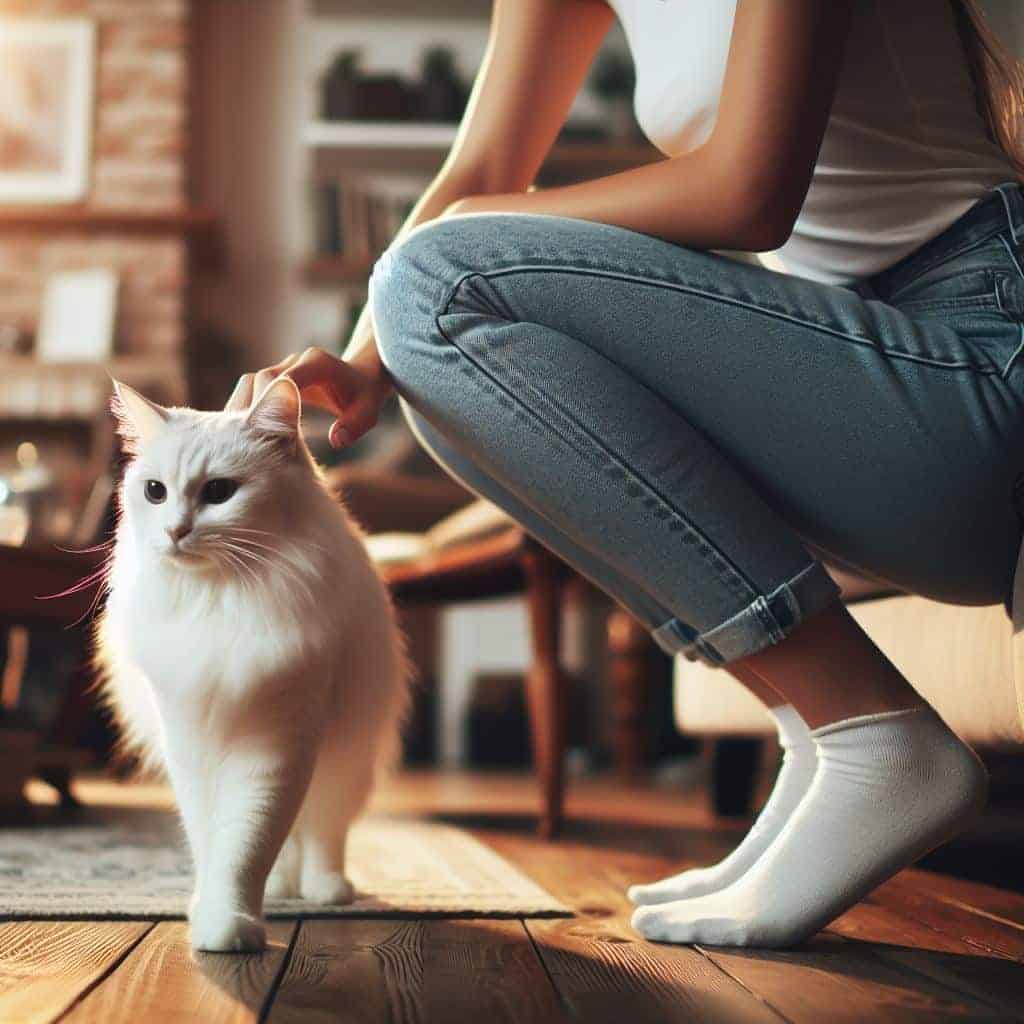
Making your home safe for a kitten is important, and knowing how to kitten proof your home can make a big difference. Kittens are curious and like to explore, which can sometimes get them into trouble.
A few years ago, I remember when Doofy was still pretty much a senior kitten, went into the kitchen and almost tipped over a pot of hot water. This experience highlights why a kitten-friendly home is essential.
Common Cat Behavior Problems often arise in unsafe environments. Kittens love to climb and chew on things, which can lead to injuries if we aren’t careful. For instance, many kittens get burns or fall because of their adventurous nature.
To ensure a safe space, blocking off dangerous spots and identifying potential hazards is crucial. A kitten-friendly home protects your pet and helps the pet and owner live happily together.
Let’s learn how to kitten-proof your home effectively for your furry friend.
How to Kitten-Proof Your Home
Make your home safe for a kitten. It’s like building a playground where they can explore safely. When I first got a kitten, it was full of curiosity and mischief.
Let’s see how you can make your home safe for your furry friend.
Finding and Removing Hazards
Common Household Hazards
Kittens are curious and may get into trouble. Small things like rubber bands, plastic bags, and toys can be choking hazards. Once, my kitten got stuck in a plastic bag. It was scary! Keep these items away from them.
Secure wires and cords because they can cause strangling or shocks.
Here’s a quick checklist to find dangers:
-
Small Objects: Put away buttons, coins, and jewelry.
-
Plastic Bags: Store them in closed cabinets.
-
Loose Wires: Use cord organizers or hide behind furniture.
Toxic Plants and Substances
Some houseplants are bad for cats. Lilies can be deadly if eaten. I removed many plants after learning this. Also, put cleaning supplies and medicines in cabinets with Child Locks. This stops kittens from eating harmful stuff.
Securing Dangerous Items
Kitchen Safety
The kitchen has many dangers for kittens. Hot stoves, sharp tools, and chemicals are some examples. Use a Midwest Wire Mesh Pet Safety Gate to keep kittens out when cooking. Install Childproof Latches for Cabinets to lock cleaning supplies and food.
Bathroom Safety
Bathrooms can be dangerous too. Toilets pose drowning risks; keep lids closed always. Store shampoos and razors in cabinets with Child Locks so kittens can’t reach harmful chemicals or sharp objects.
Managing Interactions with Other Pets
Introducing Kittens to Other Pets
Introducing kittens to other pets takes time. When I introduced my kitten to my older cat, it took weeks before they got along well. Let them sniff each other through a door first then slowly increase their time together while watching closely.
Creating Safe Spaces for Kittens
Kittens need their own space where they feel safe alone at first—a cozy corner with bed toys, a scratching post should do fine initially, off-limits until they are comfortable exploring more areas later on.
Following these steps creates a safe environment for exploration, ensuring safety and peace of mind in the future.
Managing Interactions with Children
Kittens and kids can be great friends, but they need help playing safely. I remember when my niece met my kitten, Whiskers. She was so excited! But I had to show her how to be gentle with Whiskers.
Let’s see how you can teach your kids to play nicely with your new kitten.
Teaching Children How to Handle Kittens
Kids might think kittens are toys and play with them too roughly. It’s important to show them how to hold and play with kittens. Here’s a simple guide:
-
Gentle Touch: Teach kids to pet kittens softly. Show them how to use your hand on the kitten’s back.
-
Proper Holding: Tell them to use both hands when holding a kitten. One hand goes under the chest, the other under the back legs.
-
Respect Boundaries: Explain that kittens need space and rest time. Let kids know it’s better if the kitten comes to them instead of chasing it.
-
Supervised Interaction: Always watch when young kids and kittens are playing together.
Setting Boundaries for Playtime
Play is fun for both kittens and kids, but rules keep everyone safe. Here are some tips:
-
Designate Play Areas: Make special places where kids can play with the kitten safely.
-
Use Toys, Not Hands: Encourage using toys like feather sticks or balls for playing instead of hands.
-
Time Limits: Keep play sessions short because kittens get tired fast and need breaks.
-
Teach Calmness: Remind kids to stay calm and quiet during playtime since loud sounds can scare kittens.
By teaching gentle handling and setting clear rules for playtime, you create a happy place for children and their furry friend.
Step by Step Detailed Instructions
Creating a home kitten-friendly environment involves a room-by-room approach. When I first brought Doofy home, I had to rethink every corner of my house. Let’s explore how you can make each room safe and welcoming for your new furry friend.
Room-by-Room Kitten Proofing
Living Room
The living room is often the heart of the home, where everyone gathers, including your kitten. To make it kitten-proof, start by securing all electrical cords. Kittens love to chew, and cords can be dangerous. Use cord protectors or hide them behind furniture.
Next, focus on your furniture. Opt for cat-proof furniture that can withstand scratches and spills. A cardboard cat scratcher can save your sofa from becoming a scratching post. Place it in a spot where your kitten likes to hang out. Keep small items like coins, buttons, and jewelry out of reach. These can become foreign bodies if swallowed. I once found Doofy playing with a loose button, which could have been a choking hazard.
Bedroom
The bedroom should be a safe haven for both you and your kitten. Start by securing any electrical cords, just like in the living room. Keep your closet doors closed to prevent your kitten from exploring and getting trapped.
Consider the bed. Kittens love to hide under beds, so ensure there are no small objects or foreign bodies they can swallow. Use under-bed storage to keep things tidy and safe.
A cat scratcher in the bedroom can also help redirect your kitten’s natural scratching instincts away from your furniture. Remember, keeping them safe is the priority.
Outdoor Safety Considerations
Securing Fences and Gates
If your kitten has access to the outdoors, securing your yard is crucial. Check your fences and gates for any gaps or holes. Kittens are curious and can squeeze through surprisingly small spaces. I once had a scare when my kitten found a gap in the fence.
Now, I regularly inspect and repair any potential escape routes.
Consider installing a cat-proof fence topper to prevent climbing. This can keep your kitten safe within the boundaries of your yard.
Safe Outdoor Exploration
Outdoor exploration can be enriching for kittens, but safety comes first. Supervise your kitten’s outdoor time to ensure they don’t encounter any dangers. Create a designated play area with toys and a cat scratcher to entertain them.
If you have a balcony, make sure it’s safe. Cat-proof your balcony with netting or screens to prevent falls. This way, your kitten can enjoy the fresh air without the risk of injury.
These steps will help you create a home that provides a kitten-friendly environment. Each room and outdoor space should be a safe playground for your kitten to explore and grow. Remember, a little preparation goes a long way in keeping your furry friend happy and healthy.
What You Need
When I got my first kitten, I learned that being ready is important. Making a safe place means having the right things.
Important Kitten-Safety Items
Gates and Barriers
Gates and barriers are beneficial. They stop kittens from going where they shouldn’t. I used a gate to block the kitchen. It kept my curious kitten away from dangerous places like the stove or trash can.
-
Pet Safety Gates: These gates change size to fit most doors. They’re great for keeping kittens in safe areas.
-
Barriers: Use barriers to block off spots like stairs or rooms with breakable stuff.
Gates and barriers help you relax. They ensure your kitten stays in the safe parts of the house while exploring.
Safe Cleaning Products
Kittens like to explore everywhere. This means they’ll find cleaning products too. It’s important to use safe ones to protect them. I switched to safer cleaners after seeing how often my kitten licked surfaces.
-
Natural Cleaners: Pick products made from natural things. They’re safe for kittens and the earth.
-
Avoid Strong Chemicals: Stay away from bleach and ammonia cleaners. These can be bad if eaten or breathed in.
Safe cleaning products keep your kitten from harmful stuff by accident. They also make your home healthier overall.
Who Should Try This?
Bringing a kitten home is fun and exciting. I remember when I got my first kitten. It was so cute, but I knew my home needed changes to keep it safe. Kitten-proofing isn’t just for careful people; it’s important for everyone who wants their kitten to be safe and happy.
New Kitten Owners
If you have a new kitten, congrats! You’re starting a journey full of purrs and playtime. But kittens are curious and can get into trouble easily. As a new owner, you might feel worried about keeping your kitten safe. That’s why kitten-proofing helps.
-
Why Kitten-Proof?: Kittens explore everything like toddlers do. They don’t know what’s dangerous or not. We need to make sure they are safe by creating secure spaces.
-
Essential Tools: Get Safety Gates to keep your kitten in safe areas. These gates stop them from going into risky places like kitchens or stairs.
-
Peace of Mind: When your home is safe, you can relax and enjoy time with your pet without worrying about dangers.
Families with Young Children
Having a kitten with young kids brings joy and teaches care. But both kids and the kitten must play safely together.
-
Teaching Moments: Teach kids how to gently touch and hold the kitten right. This keeps the kitten safe and helps kids learn kindness towards animals.
-
Creating Safe Spaces: Make special areas where kids and kittens can play together safely using Safety Gates to block off dangerous spots.
-
Balancing Fun and Safety: Use toys instead of hands for playing to avoid scratches or bites, making sure everyone has fun safely.
Kitten-proofing is key for anyone getting a new kitten, especially new owners and families with young children. It makes sure everyone enjoys having a kitten without worries by preparing ahead for safety at home.
Possible Problems
Handling Kitten Curiosity
Kittens are naturally curious. They explore with lots of energy and excitement. This curiosity can get them into trouble. Once, my kitten got stuck in a curtain, teaching me to secure loose fabrics and cords.
To handle this curiosity:
-
Make Safe Zones: Set up areas where your kitten can play safely. Use gates or barriers to block off dangerous places like the kitchen or bathroom.
-
Change Toys Often: Keep your kitten happy by changing their toys often. This keeps things interesting and stops them from getting into trouble.
-
Watch Playtime: Try to watch your kitten when they play. You can step in if they start doing something dangerous.
Kitten curiosity is fun to see but needs careful watching for safety. By making a safe space, you can enjoy watching your Comforted Kitty explore without worry.
Finding Safety and Freedom Balance
Balancing keeping your kitten safe and letting them explore is hard. At first, I wanted to protect my kitten from all dangers but realized too many rules could stop her from growing confidently.
Here’s how you can balance it:
-
Slowly Show New Places: Let your kitten see new parts of the house slowly. Start with one room and add more as they feel comfortable.
-
Let Them Explore Alone: Allow your kitten some freedom while ensuring it’s safe around them. This builds confidence and helps them grow well.
-
Give Cozy Spots: Make soft places where your kitten can relax when needed—a warm bed or blanket makes a nice retreat for a Comforted Kitty.
Balancing safety with freedom helps kittens become confident cats who know they have a safe place always waiting back home again after exploring adventures outside.
Important Things to Remember
When I got my kitten, I thought my home was ready. But soon, I learned that keeping a kitten safe is not a one-time job. It needs regular checks and advice from experts. Let’s see what you should know to keep your kitten safe and happy.
Keeping Safety Measures Updated
Here’s how you can stay ahead:
-
Monthly Checks: Set a reminder to look around your house every month for new dangers like loose wires or small items left out.
-
Change Barriers: As kittens grow, they might jump over or squeeze through barriers that used to work. Make sure gates still stop them.
-
Switch Toys: Kittens get bored with old toys. Change them often so they don’t find fun in unsafe places.
-
Lock Windows and Doors: Adventurous kittens might try to escape. Ensure all windows and doors are locked well.
Updating safety steps keeps your growing kitten safe and happy.
Ask a Vet for Help
Vets are great for helping with kittens. I had many questions about my kitten’s health and behavior. Talking to a vet gave me peace of mind.
Here’s why vets are helpful:
-
Health Visits: Regular vet visits check growth and catch problems early. Vets give shots and advice on food and exercise.
-
Behavior Tips: If your kitten acts strange, vets can help solve it with advice on issues like being mean or scared.
-
Safety Advice: Vets can suggest ways to make your home safer based on its layout and your kitten’s habits.
-
Insurance Ideas: Some vets suggest getting insurance for unexpected medical costs, which helps in emergencies.
Talking to a vet ensures you do your best for your kitten’s care. Their help guides you through raising a happy cat.
Making your home safe for a kitten is a must for cat owners. Taking steps to make your house kitten-proof keeps them safe and you relaxed. Begin by fixing loose wires and getting rid of small dangers. Experts say to keep your kitten in one room at first to avoid accidents. For more help, check pet care books or online groups.
Enjoy this time with your kitten, knowing you’ve made a caring and safe place for them.

In her previous life, Lisa traveled extensively, both for work and leisure. After the pandemic struck, Lisa locked up her luggage and adopted a cat ever since.
Lisa is now an avid cat lover, she devotes most of her free time serving as butler to her adorable feline at home. When she is not with her cat, she can be seen using her phone sourcing for the latest cat supplies online.


